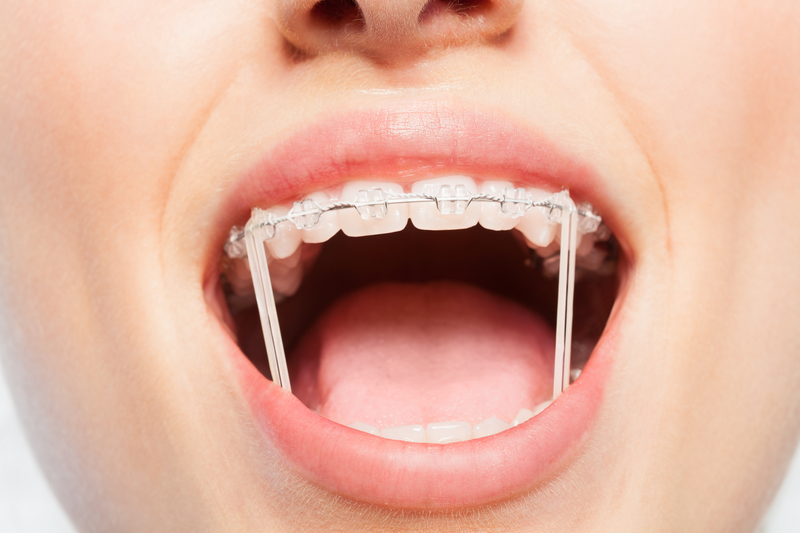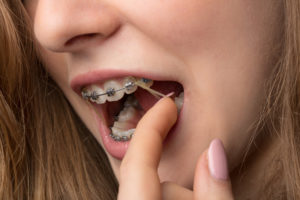How Important Is it to Wear Your Orthodontic Rubber Bands?

Wearing rubber bands is a critical part of your orthodontic treatment. We ask you to wear them 24 hours a day because they are that critical to the process of straightening your teeth. Knowing why your orthodontic rubber bands are important will help you wear them more. Consider the following reasons you need to wear your bands the next time you are tempted to put them aside.
Types of Braces
We offer several different types of braces at our office. Patients wear orthodontic rubber bands when they have traditional metal braces and ceramic braces. When you think of braces, you probably think of metal braces. These are the ones with square brackets on the front of each tooth and a wire that goes through the brackets on top and bottom. Metal braces are the most economical choice when choosing orthodontic care.
A close cousin to metal braces are clear, ceramic braces. These braces look and act like metal braces, except they are white. They have a white color to them because they are made out of ceramic material, which blends into the natural whiteness of your teeth. This is why they are known as “clear braces”. Ceramic material helps decrease demineralization that can happen when patients wear braces and don’t practice good oral hygiene habits. Both types of braces (metal and ceramic) use orthodontic rubber bands at times to move the teeth in a particular direction.

Parts of Braces
Each part of your braces is important when it comes to straightening your teeth in the best way possible in the quickest way possible. Your treatment would be lacking if you were missing any part of your braces, including orthodontic rubber bands.
- Bands – A band is a thin ring fitted to a back molar and cemented to the molar. This is usually made of stainless steel and secures other orthodontic attachments such as hooks, brackets or tubes.
- Brackets – A bracket can be bonded to the tooth with cement or it can be attached to a band. Brackets are usually made of stainless steel or clear ceramic material. They guide and support the archwire into its proper placement.
- Archwire – The archwire guides the shifting of the teeth during orthodontic treatment. Orthodontic attachments (such as the brackets) hold these wires and are made from stainless steel. Some archwires are made of titanium instead of stainless steel.
- Elastic Ties – Available in a variety of colors, elastic ties are small rubber bands that go over the brackets in order to hold the archwire in place.
- Springs – We open or close a space between teeth using the force of a small spring. These springs go between brackets and around the archwire, and are made of stainless steel or titanium.
- Orthodontic Rubber Bands
Orthodontic Rubber Bands
There are several different types of bands for braces. There are orthodontic rubber bands and there are ligatures. Ligatures are the small rubber bands that wrap around the brackets and hold the archwire in place. You will see these bands on children in a variety of colors. We switch out ligatures at every orthodontic appointment and children can mix and match the colors. They go around the brackets and protect the teeth and gums from sharp metal points and are changed when the wire is tightened or the braces are adjusted. These orthodontic rubber bands (the ligatures) are very small, as the brackets are small.
The other type of orthodontic rubber bands adjust your bite and jaw position. These will be slightly bigger orthodontic rubber bands. On your brackets, you have small hooks where these rubber bands attach. Often, you will loop a rubber band around a hook on a bracket on the lower jaw and hook it around another bracket on the upper jaw. Some patients will need several orthodontic rubber bands at a time and others will only need one. These rubber bands will adjust the position of the jaw quicker between visits.

Child Orthodontics
You will commonly see orthodontic rubber bands with child orthodontics. This is orthodontics for children under the age of 10 that need braces to correct bite and alignment issues. Orthodontic rubber bands are critical for making those changes possible. Your child should first see the orthodontist around age 7 or 8. This is a time where we can check that the bite lines up properly and that the adult teeth will come in correctly. If there is a bite or alignment problem, we give your child metal or clear braces to correct that problem. Your child will use orthodontic rubber bands throughout their treatment to provide sufficient force to bring the bite into a straight position.
Although small, orthodontic rubber bands are critical for moving the teeth. With orthodontic care, the teeth shift slowly over time. If you skip wearing these bands, your time with braces will be longer and you won’t be correcting bite and alignment problems. This is why we ask our patients to wear their orthodontic rubber bands 24 hours a day. Each part of your braces is important for creating that beautiful, straight smile you’ve always wanted. To learn more about orthodontic rubber bands or other parts of your braces, call Belmar Orthodontics today at (303) 225-9016!
Parts of Braces and Their Importance
What role does each part of braces play? The brackets, bands, wires and even our oral health guidelines all play a vital role to the health of your teeth and the success of your teeth straightening. Braces have been perfected over the years to provide you various options for teeth straightening through traditional metal braces, lingual braces, ceramic clear braces, Invisalign and more. These options weren’t available in years past, and each option has been perfected to provide you quick and efficient teeth straightening. Find out why each part of braces is important and what role each piece plays when it comes to your oral health.
Parts of Braces
Traditional metal braces have been around for decades. We still offer these braces because frankly, they work so well. Metal braces are also the most popular orthodontic option because they work to straighten your teeth the quickest and are the most cost-effective orthodontic option you can find. The metal we use is strong and sturdy. Metal braces are made from stainless steel, but can also be used in combination with titanium. There are three main parts of braces: the brackets, the wire, and the ligature elastics that go around the brackets:
- Brackets – These are the small metal pieces that are bonded to each tooth center using special glue. This glue ensures that the brackets stick to your teeth. The glue is gentle enough that it can be removed once your time with braces has finished. Brackets are made of stainless steel but also can be made white (tooth colored) or clear. These brackets hold the archwire for the teeth.
- Wire – This wire is actually known as the “archwire”. It is the metal wire that connects all of the brackets together in your mouth. You will have one archwire that is along the upper teeth and one that is along the lower teeth. This wire curves around the teeth and puts pressure on the teeth so that they come into proper alignment in the mouth. This is the main player that works to move your teeth in the right direction.
- Ligature Elastics – These are the rubber bands that attach the archwire to the brackets on each tooth. Without these ligature elastics, the archwire would not be sturdy and couldn’t do its job.
Additional Parts of Braces
There are more than just these three parts of braces.
- Headgear – This is an external appliance used in orthodontic care to help realign the face and jaw during your time with braces. There is retraction headgear and protraction headgear. Retraction headgear is an appliance used to retract the upper jaw. Protraction headgear moves the upper jaw forward and into proper alignment with the lower jaw. Headgear will consists of a single strap that fits around your neck and attaches to the front of your teeth. There is a second type of headgear that attaches to your braces, but the headgear has straps that fit over your head and neck. Not all patients will receive headgear unless it is really needed.
- Springs – Many braces have springs to help push and pull the teeth in the right direction. These springs generally attach to the arch wires and are located between the brackets of each tooth. The purpose of the springs are to open up or close up spaces between the teeth as they shift.
- Elastic Rubber Bands – Some patients need the additional shifting power of rubber bands to help the teeth move into place on schedule. These bands are attached to the brackets and will go from a lower tooth bracket to an upper tooth bracket. You will receive these rubber bands at your checkup and instruction for attaching your elastic bands at home until your next checkup.
Different Types of Braces
There are more than types of braces than just traditional metal ones. At Belmar Orthodontics we offer the following additional braces options:
- Incognito Lingual Braces – These braces quite literally go “incognito” as they are hidden inside your mouth. You will receive the same type of treatment as traditional metal braces. However, lingual braces are a hidden treatment apparatus on the tongue-side of your teeth. The brackets and metal are attached here and straighten your teeth without anyone else knowing.
- Invisalign – Invisalign is one of the stealthiest forms of teeth straightening. It is a series of transparent aligners customized to your teeth. You will change these aligners every 1-2 weeks until your smile is straight. They are easy to clean, easy to remove for eating and sports, and are virtually invisible in the mouth.
- Clear Ceramic Braces – Instead of metal, these braces are made from strong ceramic. They appear very similar to metal braces but are colored to match the shade of your teeth so they blend into the mouth. Even the archwires can be made white.
- Retainers – You will receive a retainer after your orthodontic braces treatment has been completed. Wearing your customized retainer is vital to maintaining a straight smile, as the teeth can quickly shift out of place. The first month is the most crucial as this is the time when your teeth will shift the most if a retainer isn’t worn.
Your Free Consultation
Keeping the parts of braces clean will greatly enhance your experience, so following our guidelines will help you find success with your orthodontic care. Proper braces appliances and all their parts will ensure that your teeth shift into perfect alignment in the least amount of time. If you would like to learn more about braces or need to schedule your appointment, call our Belmar Orthodontics office today at (303) 225-9016!

